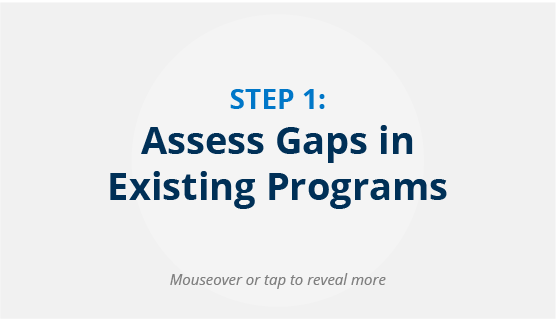Identify Solutions
To find the right solutions for your employees’ most pressing financial needs, begin by looking for gaps that could be addressed with enhancements to existing programs or new solutions.

How Do I Identify the Right Solutions?
Once you have identified and prioritized your employees’ most pressing financial health challenges, you’re ready to start thinking about ways to address them. But how will you know where to start? Should you consider your company’s compensation policies or your benefits? What about your time off policies? For your hourly workforce, what impact do your company’s scheduling practices have on your employees’ financial health?
The short answer is: All of these are potential levers that you can pull to improve worker outcomes.
3 Steps for Identifying Solutions
Identify financial health gaps that could be met with enhancements to existing programs or new solutions.

Evaluate solutions and partners to ensure that the programs you design meet the employee needs you’ve identified.

Combine compelling data with qualitative insights to help make the business case for financial health investments.

An Employer’s Role in Financial Health: A Holistic View
Well beyond providing a paycheck, employers play a significant role in their employees’ financial health. Workplace benefits make up nearly one-third of total compensation, enabling financial resilience and providing wealth-building opportunities for workers.9
Yet ample evidence suggests that other workplace policies – including scheduling and paid leave policies – also have a dramatic impact on workers’ financial well-being. Unstable and unpredictable work schedules are associated with household economic insecurity, increased hunger and other hardships, worse child behavioral outcomes, and poorer psychological and physical health.10,11 Similarly, workers without access to paid leave are more likely to be economically vulnerable.12 In both cases, lower-wage workers, particularly women and workers of color, are most likely to be exposed to these precarious working conditions.
Thus, employers must take a holistic view of their role in supporting their employees’ financial well-being, beyond just wages and benefits.
- “Employer Costs for Employee Compensation – March 2021,” Bureau of Labor Statistics, June 2021.
- Daniel Schneider and Kristen Harknett, “It’s About Time How Work Schedule Instability Matters for Workers, Families, and Racial Inequality,” The Shift Project, October 2019.
- Daniel Schneider and Kristen Harknett, “Consequences of Routine Work-Schedule Instability for Worker Health and Well-Being,” American Sociological Review, 2019.
- Daniel Schneider and Kristen Harknett, “Essential and Vulnerable: Service-Sector Workers and Paid Sick Leave,” The Shift Project, April 2020.